Are you concerned about the safety of your home? Do you want to make sure that you and your family are protected against the threat of carbon monoxide poisoning? If so, having a reliable carbon monoxide alarm in your home is important.
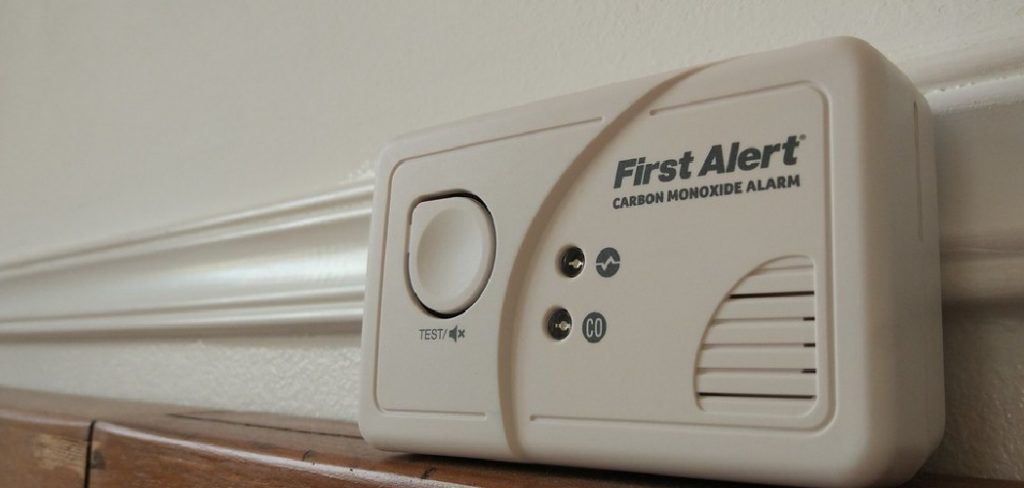
Regular testing of your First Alert Carbon Monoxide Alarm is essential to ensure it works correctly and can provide critical protection for you and your family against carbon monoxide poisoning. This colorless, odorless gas can be fatal if undetected, making a fully functional alarm a vital component of home safety.
In the following sections, we will guide you through the simple steps of how to test first alert Carbon Monoxide Alarm, helping to maintain peace of mind that your home environment is monitored and safe from this invisible threat.
What are the Benefits of Regular Testing?
Testing your First Alert Carbon Monoxide Alarm on a regular basis has several important benefits. Firstly, it can give you confidence that the alarm is working correctly and can detect any potential threat of carbon monoxide in your home. This can provide peace of mind and ensure your family is always protected.
In addition to this, testing also helps to maintain the overall performance of your alarm. Over time, dust and debris can accumulate in the sensors of the alarm, causing them to become less sensitive and potentially leading to false alarms or even failure to detect carbon monoxide. Regular testing allows you to identify any issues early on and take necessary steps for maintenance or replacement if needed.
Lastly, regular testing is also beneficial for the longevity of your carbon monoxide alarm. By keeping it well-maintained and consistently checking its functionality, you can ensure that it will continue providing reliable protection for years.
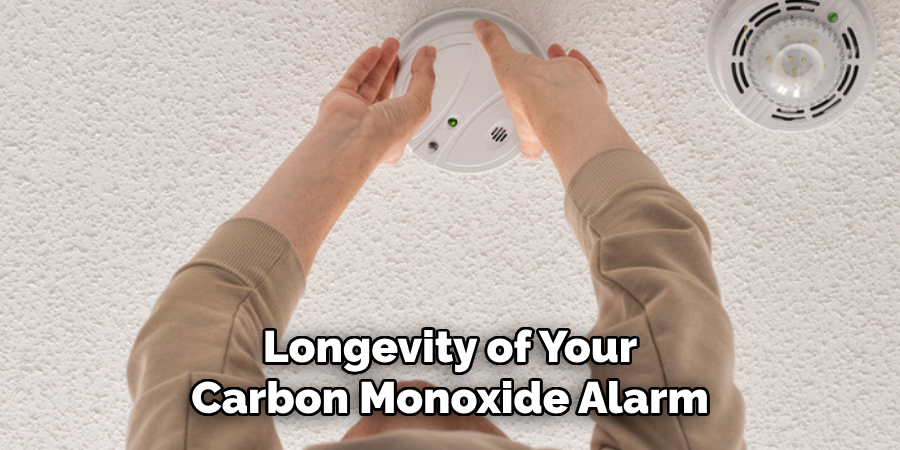
What Will You Need?
Before we begin the testing process, you should have a few things on hand.
- Your First Alert Carbon Monoxide Alarm
- A can of canned carbon monoxide test spray
- A flashlight
- Protective gloves (optional)
Once you have gathered these items, you are ready to begin testing your alarm.
10 Easy Steps on How to Test First Alert Carbon Monoxide Alarm:
Step 1: Locate Your Alarm
The first step is to locate your First Alert Carbon Monoxide Alarm. The most common place to install a carbon monoxide alarm is in the hallway outside of bedrooms or near sleeping areas. If you have multiple levels in your home, it’s recommended to have an alarm on each floor.
Step 2: Read the User Manual
Before proceeding further, it’s crucial to familiarize yourself with the specific model of your First Alert Carbon Monoxide Alarm by reading the user manual thoroughly. Each model may have slightly different functionalities and testing procedures. The manual will provide detailed instructions on how your particular model operates, where the test button is located, and any precautions you should take before testing the alarm.
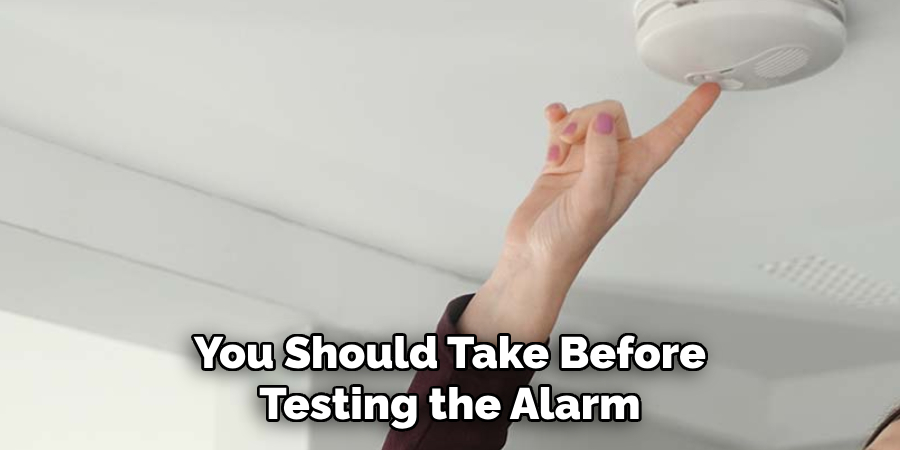
Additionally, the manual may offer guidance on regular maintenance tasks, such as cleaning and battery replacement, to ensure your alarm operates effectively year-round. Understanding your device fully will make the testing process smoother and enhance your overall safety measures.
Step 3: Prepare the Alarm
Before testing the alarm, ensure it is mounted correctly on the wall or ceiling and that there is nothing obstructing the alarm’s vents, which could affect its ability to detect carbon monoxide.
Check that the alarm is not in a “fault” or “off” mode, which may be indicated by a specific light pattern or by consulting the user manual. If your alarm is battery-operated, consider replacing the batteries if they have yet to be changed recently to ensure the test runs smoothly. This preparation step is crucial for an accurate test result.
Step 4: Press the Test Button
The next step is to test your alarm’s functionality by pressing the test button. This button is usually clearly marked and found on the front or side of the alarm. Press and hold the test button for a few seconds until the alarm beeps.
This beep indicates that the electrical circuitry within the alarm is functioning correctly. It’s important to note that while this test checks the alarm’s operational status, it does not test the alarm’s ability to detect carbon monoxide. Continue to the next steps for a more comprehensive test of the alarm’s capabilities.
Step 5: Apply the Test Spray
After confirming the alarm’s operational status through the test button, the next step is to simulate a carbon monoxide environment to ensure the alarm can detect this dangerous gas. Wear protective gloves if desired, and shake the can of carbon monoxide test spray as recommended by its instructions.
Hold the can approximately 6 inches from the alarm’s vents and spray a small amount of test gas directly toward the unit. It’s important to avoid over-spraying, as excessive amounts could damage the sensor or cause false alarms in the future.
Step 6: Observe the Alarm’s Response
Once you’ve applied the test spray, observe the alarm closely for its response. A functioning alarm should emit a loud, piercing sound within a few minutes, indicating it has successfully detected the carbon monoxide. This test confirms that the alarm’s sensor is sensitive and operational.
If the alarm does not respond to the test gas, it may signify that the sensor is defective or that the alarm system needs maintenance. In such cases, consult the user manual for troubleshooting tips or contact First Alert’s customer service for further assistance. Remember that timely detection of carbon monoxide can save lives, making this step crucial in the testing process.
Step 7: Ventilate the Area
After testing the alarm with the carbon monoxide test spray, it’s critical to properly ventilate the area to ensure any residual gas is cleared. Open windows and doors near the alarm to allow fresh air to circulate. Operating a fan can also help expedite the process.
Ensuring the area is well-ventilated safeguards your health and helps prevent the alarm from continuously detecting the test gas, which could lead to unnecessary alarms. Proper ventilation after testing is essential to resume normal operation and safety conditions in your home.
Step 8: Reset Your Alarm
Following the test area’s ventilation, reset your First Alert Carbon Monoxide Alarm to ensure it returns to its normal monitoring mode. The process for resetting the alarm can vary between models, so refer to your user manual for specific instructions.
Generally, resetting the alarm involves pressing and holding the test button for a few seconds or disconnecting the battery for a battery-operated unit and then reconnecting it. This action clears any error states induced by the testing process and prepares the device for regular operation. It’s crucial to complete this step to continue safeguarding your home against carbon monoxide efficiently.
Step 9: Conduct a Final Check
After resetting your First Alert Carbon Monoxide Alarm, conduct a final check to ensure it functions correctly in its normal monitoring mode. This can be done by simply observing the alarm’s indicator lights or display, which should signify normal operation as outlined in the user manual.

If your model has a digital display, check for any error messages or abnormal readings. It’s also wise to listen for any irregular beep patterns that might indicate a fault. This final step guarantees that your alarm is fully operational and ready to protect your home and family from the dangers of carbon monoxide. If any issues persist, contact First Alert’s customer service for support.
Step 10: Schedule Regular Testing
It’s essential to schedule regular testing of your First Alert Carbon Monoxide Alarm to ensure its continual effectiveness in detecting dangerous levels of carbon monoxide. Mark your calendar for routine maintenance and testing procedures, such as battery replacement, alarm cleaning, and sensor testing, to take place at least once every six months.
Adhering to a consistent testing schedule helps identify potential issues early and maintains the alarm’s optimal performance. Keeping a log of testing dates and maintenance activities can also be beneficial for future reference. Regular vigilance in testing and maintenance ensures the safety and security of your living environment against the threat of carbon monoxide.
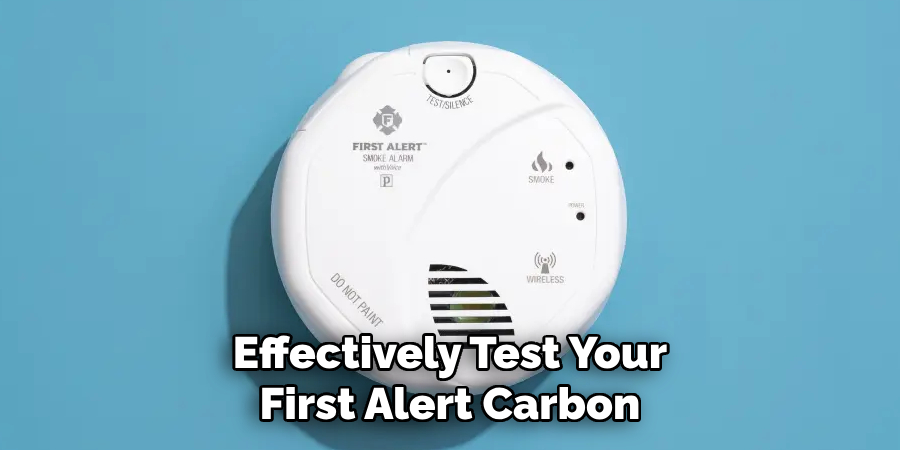
By following these ten simple steps, you can confidently and effectively test your First Alert Carbon Monoxide Alarm to ensure it’s functioning correctly.
5 Additional Tips and Tricks
- Use the Right Test Method: Avoid using any method that could harm the sensor, such as using smoke or actual carbon monoxide to test the alarm. Stick to using the test button for a safe and simple check that your alarm works.
- Check Battery Life: Even if your alarm is hardwired, it likely has a backup battery. Test the battery life and replace it annually, or as recommended by the manufacturer, to ensure your alarm functions during a power outage.
- Clean Regularly: Dust and debris can accumulate on your alarm, potentially hindering its sensitivity. Gently clean the outside of your alarm with a dry cloth when you perform your monthly test to maintain its accuracy.
- Educate Your Household: Make sure all household members know the sound of the alarm and understand the procedure for testing it. Practice your emergency evacuation plan regularly to ensure everyone knows what to do if the alarm goes off.
- Replace Old Alarms: Carbon monoxide alarms have a 5-7-year lifespan. After that, their sensors may start to degrade, making them less effective in detecting carbon monoxide. Make sure to replace your alarm before it reaches the end of its lifespan for maximum protection.
With these additional tips and tricks, you can ensure that your first alert carbon monoxide alarm is functioning properly and providing the best protection for you and your household.
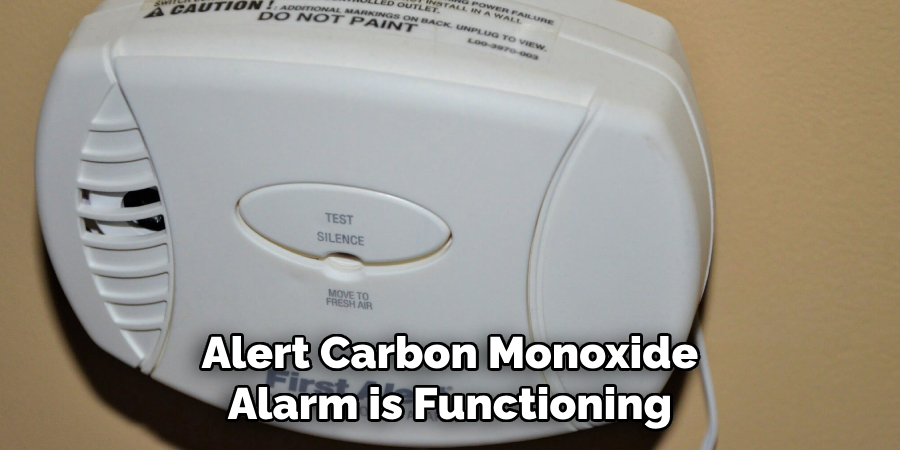
5 Things You Should Avoid
- Do Not Ignore Manufacturer Instructions. Always follow the testing procedures recommended by the manufacturer. Attempting to test the alarm in any way other than specified can lead to incorrect results or even damage to the device.
- Avoid Using Actual Carbon Monoxide: Never attempt to use real carbon monoxide to test the alarm. This is extremely dangerous and could lead to carbon monoxide poisoning.
- Do Not Paint Over the Alarm: Painting or decorating your carbon monoxide alarm can obstruct vents and interfere with its ability to detect carbon monoxide effectively.
- Avoid Disabling the Alarm: Never disable your alarm to stop nuisance alarms. If it’s going off frequently, it’s essential to investigate the reason rather than disconnecting the device.
- Do Not Rely Solely on the Test Button: While using the test button is a safe way to ensure your alarm is working, it only tests the alarm’s sound mechanism and circuitry. It does not confirm the sensor’s ability to detect carbon monoxide, so always ensure your alarm is within its service life and functioning correctly in all aspects.
By avoiding these actions, you can ensure your first carbon monoxide alarm is working accurately and providing the best protection for your household.
Do Carbon Monoxide Detectors Always Beep?
No, carbon monoxide detectors do not always beep. While they are designed to sound an alarm when dangerous levels of carbon monoxide are detected, there are several reasons why a carbon monoxide detector may not beep:
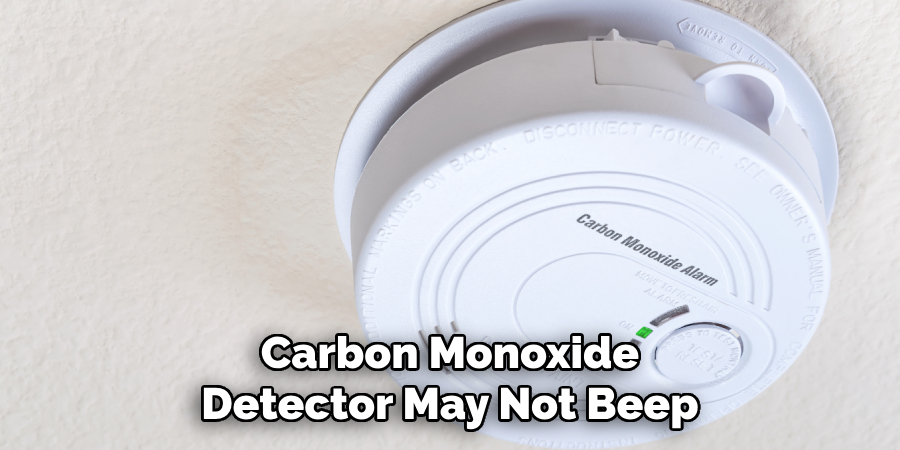
- The Alarm Has Expired: Carbon monoxide detectors have a lifespan of 5-7 years, after which their sensors may start to degrade. If your alarm has reached its expiration date, it may not beep when carbon monoxide is present.
- The Alarm Is Faulty: Carbon monoxide alarms can malfunction and stop working like any electronic device. If you have followed all the testing procedures outlined in the user manual and your alarm still does not beep, it may be defective.
- The Battery Is Dead: Carbon monoxide alarms generally have a backup battery in case of a power outage. If the alarm is not beeping, try replacing the battery to see if that resolves the issue.
- Low Levels of Carbon Monoxide Detected: While carbon monoxide detectors are designed to detect dangerous levels of carbon monoxide, they may not beep for low levels that are still above the recommended threshold. If you suspect carbon monoxide, but your alarm is not beeping, evacuate your house and seek professional assistance.
In conclusion, while carbon monoxide detectors are designed to beep when dangerous levels of carbon monoxide are detected, there may be several reasons why they do not sound an alarm. It’s essential to regularly test and maintain your detector to ensure it is functioning correctly and providing the best protection for your household. So, proper maintenance is a must!
What are the Signs of Carbon Monoxide Poisoning?
Carbon monoxide poisoning can be a silent killer, as it is a colorless and odorless gas. The signs of carbon monoxide poisoning may not always be obvious, but they can range from mild to severe symptoms. Some common signs to look out for include:
- Headaches: A headache is one of the most common symptoms of carbon monoxide poisoning. If you experience frequent headaches, it’s essential to consider the possibility of carbon monoxide in your living environment.
- Nausea and Vomiting: Exposure to carbon monoxide can also cause nausea, vomiting, stomach pain, and discomfort.
- Dizziness and Confusion: Carbon monoxide can affect your brain, leading to dizziness and confusion. If you or anyone in your household is experiencing these symptoms, evacuate the area immediately and seek medical attention.
- Difficulty Breathing: Carbon monoxide can also cause difficulty breathing, chest pain, and shortness of breath.
- Blurred Vision: Exposure to carbon monoxide can affect your vision, causing blurred vision or even temporary blindness.
If you experience any of these symptoms and suspect carbon monoxide poisoning, evacuate the area immediately and seek medical attention. Having a carbon monoxide detector in your household is crucial to help detect this gas before it causes harm. So, make sure to follow all safety guidelines for optimal protection!
How Does the Carbon Monoxide Detector Work?
Carbon monoxide detectors work by using sensors to detect the presence of carbon monoxide in the air. When the sensors detect a certain level of carbon monoxide, they trigger an alarm to alert you of potential danger. There are three main types of sensors used in carbon monoxide detectors:

- Metal Oxide Semiconductor (MOS) Sensor: This type of sensor uses a chemical reaction between carbon monoxide and oxygen to produce an electrical current. When the current reaches a certain threshold, the alarm is triggered.
- Electrochemical Sensor: This type of sensor also uses a chemical reaction but instead measures the electrical current produced by the reaction to determine the level of carbon monoxide in the air.
- Biomimetic Sensor: This newer type of sensor mimics the way our bodies react to carbon monoxide. It uses a colored gel that changes color when exposed to the gas. The color change then triggers an alarm.
In all types of sensors, once the alarm is triggered, the detector will sound an audible alert and may also flash a visual warning light. Some detectors are also equipped with a digital display showing the level of carbon monoxide detected.
Conclusion
In summary, how to test first alert carbon monoxide alarm is crucial for protecting your household from the silent dangers of carbon monoxide poisoning. Regularly testing your alarm, avoiding common mistakes such as ignoring chirping signals or using expired alarms, and understanding the principles behind how carbon monoxide detectors work are key steps to maximizing your safety.
Remember, the best defense against carbon monoxide poisoning is a well-maintained detector and awareness of the symptoms and risks associated with carbon monoxide exposure.
Stay informed, stay safe, and regularly test your first carbon monoxide alarm to ensure it is always ready to protect you and your loved ones.
About
Safety Fic is a distinguished figure in the world of Diy design, with a decade of expertise creating innovative and sustainable Diy solutions. His professional focus lies in merging traditional craftsmanship with modern manufacturing techniques, fostering designs that are both practical and environmentally conscious. As the author of diy, Safety Fic delves into the art and science of Safety Fic-making, inspiring artisans and industry professionals alike.
Education RMIT University
(Melbourne, Australia) Associate Degree in Design (Safety Fic) Focus on sustainable design, industry-driven projects, and practical craftsmanship. Gained hands-on experience with traditional and digital manufacturing tools, such as CAD and CNC software.
Nottingham Trent University
(United Kingdom) Bachelor’s in diyfastly.com and Product Design (Honors) Specialized in product design with a focus on blending creativity with production techniques. Participated in industry projects, working with companies like John Lewis and Vitsoe to gain real-world insights.
Publications and Impact
In diy, Safety Fic his insights on indoor design processes, materials, and strategies for efficient production. His writing bridges the gap between artisan knowledge and modern industry needs, making it a must-read for both budding designers and seasoned professionals.
